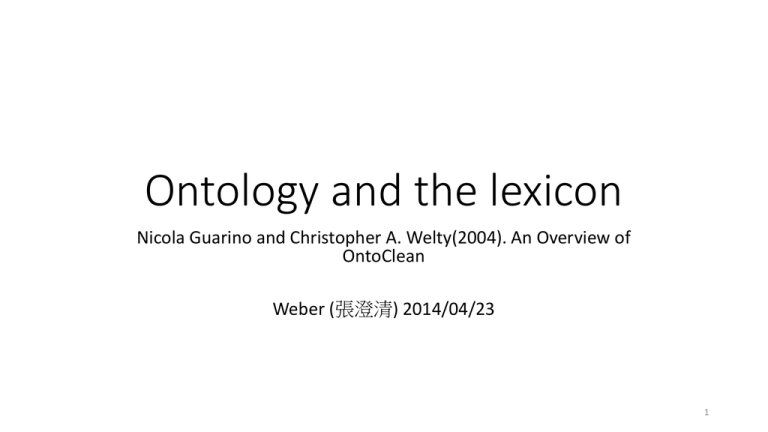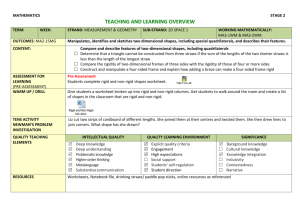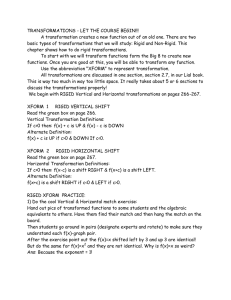Weber
advertisement

Ontology and the lexicon Nicola Guarino and Christopher A. Welty(2004). An Overview of OntoClean Weber (張澄清) 2014/04/23 1 Outline • Introduction • Basic notions • • • • • Rigidity Identity Unity Dependence Constraints and Assumptions • Methodology • Example • Conclusion 2 Introduction • domain modelers can structure a taxonomy, but unable to justify themselves to others • OntoClean provided a logical basis for arguing against the most common modeling pitfalls • basic notions in OntoClean were not new • property and class are used in computer science with different meaning from the original(property in RDF) • Subsumption, properties, classes • Basic notions: essence, rigidity, identity, unity, and dependence • Adopt a first-order logic 3 Introduction • If time argument is omitted for predicate ɸ, then the predicate is assumed to be time invariant, that is • Identity relation will be assumed as time invariant: if two things are identical, they are identical forever • □ ɸ means ɸ is necessarily true, i.e., true in all possible worlds; ◊ ɸ means ɸ is possible true, i.e., true in at least one possible world • Domain of quantification will be that of possibilia the extension of predicates will not be limited to what exits in the actual world • the examples will not be the point 4 Rigidity • Definition 1 _A rigid property is a property that is essential to all its instances, i.e, a property ɸ such that: i.e., PERSON as rigid • Definition 2 _A non-rigid property is a property that is not essential to some of its instances, i.e. , i.e., having a brain in our Wizard of Oz world • Definition 3 _An anti-rigid property is a property that is not essential to all its instances, i.e. , i.e., STUDENT as anti-rigid 5 Rigidity • Rigid properties(+R), non-rigid properties(-R), and anti-rigid properties(~R) • Rigidity as a meta-property is not “inherited” by sub-properties, PERSON+R and ∀𝑥 𝑆𝑇𝑈𝐷𝐸𝑁𝑇 𝑥 → 𝑃𝐸𝑅𝑆𝑂𝑁 𝑥 • anti-rigid is “inherited”: any property subsumed by STUDENT must be anti-rigid anti-rigid properties cannot subsume rigid properties 6 Identity • Identity condition (IC) for an arbitrary property ɸ is usually defined as a suitable relation 𝜌 satisfying the : • When a relation 𝜌 satisfying exists for a property ɸ , we say the property ɸ carries an IC • Problem 1: distinguishing between supplying an IC and carrying an IC Non-rigid properties only carry their ICs, rigid properties supply 7 Identity • Problem 2: the nature of 𝜌 relation: what make it an IC, how can we index it with respect to time to account for the difference between synchronic and diachronic identity? i.e., IC for PERSON may be the formula fingerprint(x, t)= fingerprint(y, t’) 8 Identity • An IC is necessary if it satisfies (3) and sufficient if it satisfies (4), and need not be both. This is weaker than 9 Identity Time duration Time interval 1:00~2:00 Next Tue. 2:00~3:00 Next Wed. 10 Unity 11 Unity 12 Unity 13 Dependence • An externally dependent property is +D (-D otherwise) 14 Constraints and Assumptions • Given two properties, p and q, when q subsumes p, the following constraints hold: • • • • • q is anti-rigid, then p must be anti-rigid q carries an identity criterion, then p must carry the same criterion q carries a unity criterion, then p must carry the same criterion q has anti-unity, then p must also have anti-unity q is dependent on property c, then p is dependent on property c 15 Constraints and Assumptions • Sortal Individuation: Every domain element must instantiate some property carrying an IC (+I). In this way we satisfy Quine’s dicto “No entity without identity” • Sortal Expandability: If something is an instance of different properties (for instance related to different times), then it must be also instance of a more general property carrying a criterion for its identity 16 Methodology • Assigning Meta-Properties • Analyzing Rigid Properties • The Backbone Taxonomy • Analyzing Non-rigid Properties • Phased Sortals • Roles • Attributions 17 Methodology 18 Methodology • Useful property kind All possible combinations of meta-properties 19 Methodology • Ontology-based modeling principles Unity and identity assumption Ideal taxonomy structure 20 Summary • rigid property is a property that is essential to all its instances(+R) • non-rigid property is a property that is not essential to some of its instances(-R) • anti-rigid property is a property that is not essential to all its instances • Any property carries an IC iff it is subsumed by a property supplying this IC(including the case where it supplies the IC itself) • A property ɸ supplies an IC iff (1) it is rigid; (2) there is an IC for it; (3) the same IC is not carried by all the properties subsuming ɸ. This means that, if ɸ inherits different(but compatible) ICs from multiple properties, it still counts as supplying an IC. 21 Summary • property carrying an IC is marked +I (-I otherwise); property supplying an IC is +O (-O otherwise) • Any property carrying an IC (+I) is called a sortal • A property ɸ carries a unity condition (+U) iff there exists an equivalence relation ω such that all its instances are intrinsic wholes under ω • A property has anti-unity (~U) if every instance of the property is not necessarily a whole • a property ɸ is externally dependent on a property Ψ if, for all its instances x, necessarily some instance of y must exist, which is not a part nor a constituent of x 22 Example 23 Assigning Meta-property 24 Assigning Meta-property 25 Assigning Meta-property 26 Assigning Meta-property 27 Analyzing Rigid Properties • Living beings are not amounts of matter: ~U/+U violation; IC: amounts of matter have an extensional identity • Physical objects are not amounts of matter: ~U/+U violation; Physical objects are not themselves amounts of matter, they are constituted of matter • Social entities are not groups of people: ~U/+U violation; social entity more than a group of people, must be somehow unified • Animals are not physical objects: being alive is an essential property for animals, not for physical object 28 Analyzing Non-rigid Properties • Phased Sortals: • whose instances are allowed to change certain of their identity criteria during their existence • canonical example is a caterpillar • independent, anti-rigid, and supply identity criteria • Roles: • participates to a contingent event or state of affairs • anti-rigid; differently from phase sortals, do not supply identity criteria • Attributions: • the proper way to model attributions is with a simple attribute, like color, and a value, such as red 29 Outcome 30 Conclusion • heavier lines indicate subsumption relationships between members of the backbone taxonomy • subsumption is often used to represent things other than subsumption, can be described on language using “is a” • Sometimes “is a” is not logically consistent with the subsumption relationship 31 Reference • Welty, C. and Guarino, N. 2001. Supporting ontological analysis of taxonomic relationships. Data and Knowledge Engineering, 39(1): 51– 74. 32





